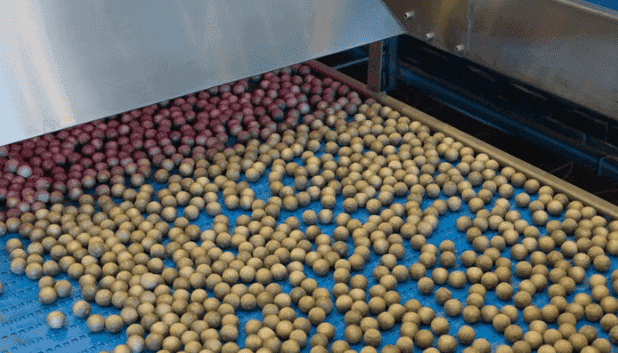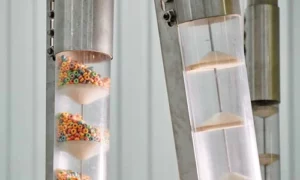Embark on a journey through the intricate world of nut processing with our in-depth exploration of different types of nut conveyors and cutting-edge conveyor manufacturing. Here, precision and efficiency are crucial, and the choice of conveyance systems must be the right one. Let’s navigate the nuanced terrain to unveil the optimal solutions for gentle and effective nut handling.
This blog post will explore the different transfer systems typically used to move nuts like cashews, peanuts, brazil nuts, macadamia nuts, pine nuts, hazelnuts, pistachios, and walnuts. We will also compare various conveyors to reveal which automatic conveyor system works best for nuts.
What Are the Different Types of Nut Conveyors?
Various conveyance systems cater to the unique demands of nut processing, including bucket elevators, chain disc conveyors, vacuum conveyors, pneumatic conveyors, screw conveyors, aero-mechanical conveyors, and cable and disc tubular drag conveyors. Each type offers distinct advantages and challenges, influencing the delicate balance between preserving nut quality and ensuring efficient production in the food industry.
Conveyor technologies for food processing come in all shapes and sizes. They can even be custom-built depending on a range of factors, including the type of material that needs to be moved and the available space for the system.
Specialized Conveyor Solutions in Nut Processing Plants
For the nut industry, some production companies may have strict requirements for their conveyors, including an inspection system consisting of metal detectors and X-ray inspection. A snack food processing plant may need blending systems to mix and blend different types of nuts.
Another nut production plant may work exclusively with almonds, an edible tree nut. The almond processing plant may require a flexible design that moves the almonds through a processing conveyor that takes it to be mixed with breakfast cereal.
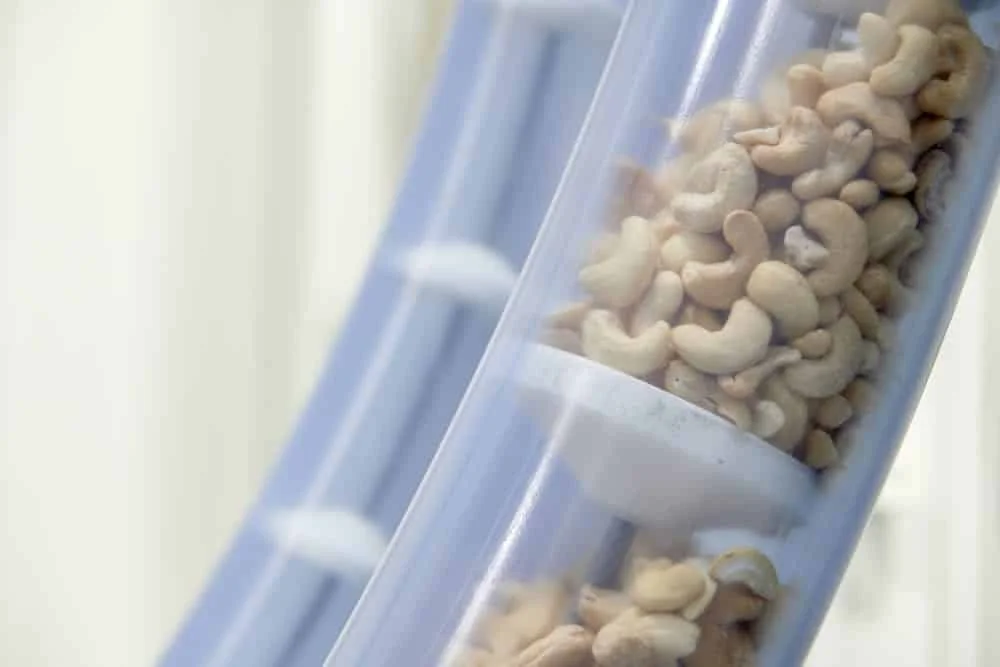
Common Types of Conveyors Used to Move Nuts
Conveyor technologies for food processing come in all shapes and sizes. They can even be custom-built depending on a range of factors, including the type of material that needs to be moved and the available space for the system.
Different processing plants have different conveyor requirements. While one facility may need an incline conveyor, others may need vibrating conveyors. One company may need tube conveyors, vertical conveyors, or a belt conveyor system that only moves products in a horizontal motion.
Because the nut industry has exceptional quality standards, it’s crucial to use the right automated conveyor system to move materials like these during processing and packaging. Here are the most common types of conveyors used in the nut industry.
Bucket Elevators Are Great for Lifting Materials Vertically
A bucket conveyor comprises a sequence of buckets affixed to a belt, featuring pulleys situated at both the top and bottom of the structure. This type of conveyor is well-suited for vertically lifting materials, and it also possesses the capability to transport materials horizontally.
The biggest downside to bucket elevators is their high maintenance cost – cleaning out accumulated fines from within the bucket elevator coving takes a lot of time and effort and is challenging to do right.
Chain Disc Conveyors Offer Enclosed Protection
Chain conveyors provide a protective enclosure for materials during transit, ensuring their safety. These conveyors offer versatile movement capabilities, allowing materials to be transported in any direction with multiple inlets and discharges. While resembling drag cable conveyors, the key distinction lies in the use of a chain for material conveyance.
This chain is made of heavy links, occupies a lot of space in the conveying tube (more than a cable), and is difficult to properly clean and sanitize. Furthermore, approximately two to three times more energy is required to operate material handling in a tubular chain disc conveyor compared to a cable and disc conveyor.
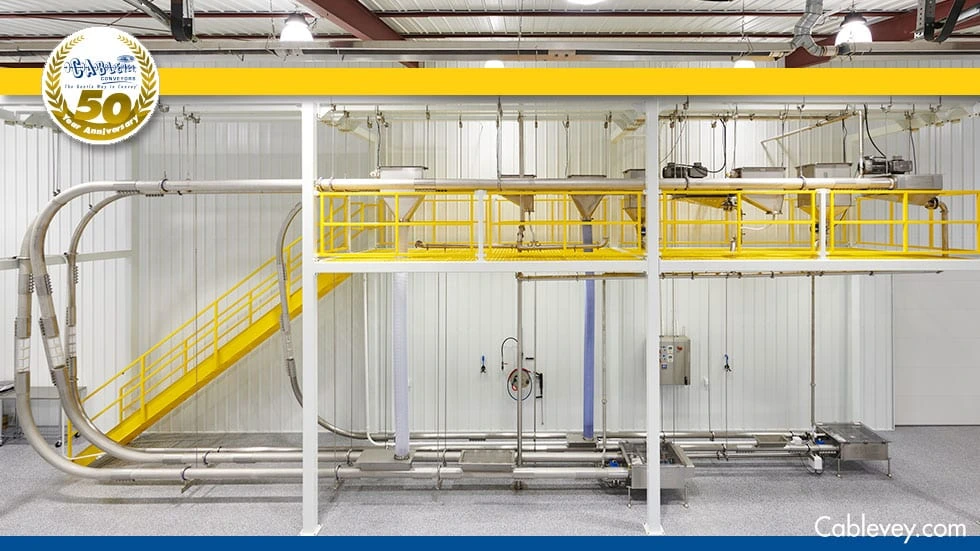
Vacuum Conveyors Transport Materials Through Tubes
A vacuum conveyor system consists of loading points (product intake points), a transport line, a vacuum conveyor, and a control system. Vacuum conveying works by transferring materials through a network of tubing using suction. The material is sucked through the pipeline and collected in a collection tank.
Even though conveying materials using a vacuum is pretty fast, product integrity suffers greatly. Any nuts you plan on transporting are bound to experience severe breakage and loss of quality.
Pneumatic Conveyors Develop High Speeds
Pneumatic conveyor solutions move materials by transmitting a propulsion force of air. The materials travel through enclosed convey lines due to air typically generated from a blower, fan, or compressor.
Similar to vacuum conveyors, pneumatic material handling systems also generate high speeds. However, at the same time, they are not gentle on the material in any way. That’s why tube and belt conveyor manufacturers don’t recommend it for handling fragile materials.
Screw Conveyors Are Ideal for Bulk-Handling Industries
A screw conveyor or auger conveyor is one of the conveyor belt systems that uses a helical screw element that rotates around a central shaft. The material moves up one pitch with every revolution of the steel auger. Even though this conveyor is great for many bulk-handling industries and plants that convey waste, it is not ideal for delicate or fragile food products.
Namely, the helical auger has blades that cut right through the conveyed material and can even compromise blends. For fragile materials such as nuts, this is not a good option for preserving product integrity.
Aero-Mechanical Conveyors Offers Efficiency
Aero-mechanical conveyors are commonly known as “rope and disc” conveyors, characterized by a setup featuring evenly spaced discs connected to a wire rope. This system operates with the rope and discs swiftly circulating in a continuous loop within steel tubes. Material is propelled by the airstream generated as a result of the rapid movement of the rope and discs.
To reduce breakage at sweeps, aero-mechanical systems have to operate at greatly reduced speeds. Additionally, rope-tensioning is required, meaning that maintenance takes longer and could lead to unnecessary costs.
Cable and Disc Tubular Drag Conveyors Offer Smooth Glide of the Material
The tubular cable and disc drag conveyor system, enclosed for optimal performance, delicately manages materials while upholding food safety. This conveyor system employs cable and disc tube technology, incorporating conveyance tubes with cables and discs affixed at specified intervals. The movement of materials in these tubular automated conveyor systems involves entering the conveying tube and descending between the discs on the cable, facilitating a smooth, air and force-free glide of the material.
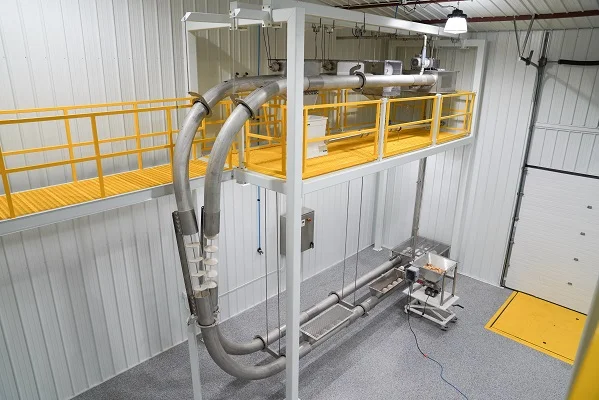
What Is the Best Conveyor System for Nuts?
Materials like nuts are fragile and need gentle conveyance to ensure they are not damaged, wasted, or lost during production. If you’re conveying specialty nuts from the roaster to the drying table or from a conveyor belt system to a packaging machine, you want to minimize breakage and product degradation to retain the value of the specialty nut.
Companies use all types of manufacturing conveyor systems to move nuts. Unfortunately, many don’t realize they have been using the wrong conveyor system until waste from breakage accumulates and the costs of broken nuts pile up. The problems associated with conveyors like bucket elevators, chain-disc conveyors, vacuums, aero-mechanical systems, pneumatic systems, and screw augers aren’t understood until the conveyor is installed and in use.
- Bucket Elevators and Hydration Impact
Bucket elevators are especially problematic with nuts like pecans, which undergo a flotation process that separates the pecan meat from its shell. Because the production process involves hydration, wet pecans may end up sticking to the bottoms and sides of the buckets when they are conveyed. And once they dry, you face issues with cleaning the buckets and maintaining sanitary processing environments.
- Vacuum, Screw Augers, and Pneumatic Conveyor Systems and Breakage Challenges
The problem with using vacuums or pneumatic conveyor systems is the high risk of breakage. Vacuums suck the materials, while a pneumatic system uses compressed air to blow the materials in the right direction. These systems are great until the nuts have to go around a sweep in the system. Being forced through a bend too quickly can cause the nut to break.
Also, these systems force the nuts to come out of the discharge points and encounter gravity, which may cause the nuts to become damaged on impact. Screw augers have also been used to convey nuts; however, screw augers tend to grind up nuts, especially fragile ones, into small pieces, which results in degradation or wastage.
- Simple Conveyor Belts
The problem with using open belt conveyors when carrying nuts from bins, elevators, or sorting stations is that dust from the nuts can escape the belts and end up on the plant’s floor and equipment. This leads to a significant amount of manual labor and housekeeping to clean and sanitize the production floor, which costs time and money.
Optimal Nut Handling – Advantages of Cable and Disc Tubular Drag Conveyors
When it comes to which conveyor system is best for nuts, cable and disc tubular drag conveyors come out on top because they minimize nut attrition and keep the processing facility clean. Nut material is carried gently without being blown about, forced through sweeps, bumped, battered, or stressed by friction. This minimizes damage and imperfections to the nuts, which lead to diminished value, product loss, or low-quality products.
Enclosed tubular conveyor systems ensure materials stay clean and safe while in transit, keep wastage at a minimum, and keep the facility sanitary and dust-free. The tubular conveying system holds fines safely inside the tube until it is time to unload them during the “return” on the empty side of the conveyor.
Explore Why Tubular Cablevey Conveyors Are the Best for Gentle Nut Handling
Nuts are fragile, and nut production companies need a conveyor system designed to move materials gently and meet the unique demands of nut processing. Not all food conveyors and process equipment are compatible with the nut industry. Because industrial conveyor systems are a diverse class of machinery, it’s essential to understand the different types of nut conveyors before investing in a system for your nut production plant’s processing line.Whether you seek expertise in conveyor installation supervision or effective cleaning conveyor belts, Cablevey Conveyors stands as your trusted partner. For more insights on how to transport nuts with utmost gentleness and efficiency, reach out to us. We’re dedicated to assisting you in making informed choices for your nut production plant’s success.

